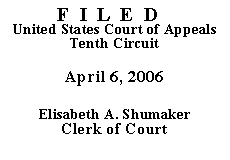

| UNITED STATES OF AMERICA,
Plaintiff-Appellee, Defendant-Appellant. |
No. 04-2334
(D.C. No. CR-03-1210-WJ) (D.N.M.) |
The indictment alleged that Mr. Burns, "having been convicted of crimes punishable by imprisonment for a term exceeding one year, kidnaping, robbery, and aggravated battery . . . , did knowingly possess . . . a firearm, a Kel Tec, .9mm handgun . . . ." Rec., vol. I, doc. 1 at 1. The government made the following statements at the plea hearing to establish a factual basis for Mr. Burns' guilty plea. Police officers, in responding to a disturbance call, attempted to stop a blue Geo Metro in which Mr. Burns was a passenger. A high-speed chase ensued, and the vehicle crashed into a fence. Other officers arrived at the scene and discovered a black Kel Tec. nine millimeter handgun in a nearby yard. Upon being questioned regarding the gun, Mr. Burns stated that it belonged to him. He also stated that he and the driver of the vehicle had been at a party, had gotten in an altercation with several individuals, and that he had fired two shots into the ground from the vehicle as it drove away. The court then had the following colloquy with Mr. Burns, who had been duly sworn:
THE COURT: Now, Mr. Burns, did you hear what the prosecutor just stated?
THE DEFENDANT: Yes, Your Honor, I did.
THE COURT: Now, do you agree with all the facts she recited into the record?
THE DEFENDANT: Yes, sir.
Rec., vol. III at 15-16 (Trans. Of Plea Hearing). Counsel for Mr. Burns made clear at the hearing that he was reserving the right to challenge pursuant to Blakely any enhancements to Mr. Burns' sentence that might be recommended in the presentence report (PSR).
The PSR essentially recited the same facts set forth at Mr. Burns' plea hearing. It also recommended the following: 1) a four-level enhancement pursuant to U.S.S.G. § 2K2.1(b)(5) for possession of a firearm in connection with the commission of another felony offense, namely, the New Mexico state offense of shooting from a motor vehicle in violation of N.M. Stat. Ann. § 30-3-8; 2) an assessment of two criminal history points for committing the charged offense while under a criminal sentence; and 3) an assessment of one criminal history point for committing the charged offense within one year of release from incarceration. The PSR concluded accordingly that Mr. Burns' total offense level was 21, which resulted in a guideline range of 57 to 71 months when combined with a criminal history category of IV. As predicted, Mr. Burns objected to the recommendations under Blakely. The district court nonetheless adopted the PSR and sentenced him to 57 months, after stating that Mr. Burns had admitted at the plea hearing to the facts supporting the enhancements. Rec., vol. IV at 17.
Mr. Burns filed this timely appeal requesting remand and resentencing in light of the Supreme Court's subsequent decision in Booker, which is applicable to this direct appeal. The government concedes that this is an appropriate remedy in light of the district court's mandatory application of the guidelines. Aple. Br. at 7.
Pursuant to Booker, a district court's application of the guidelines as mandatory rather than advisory constitutes "non-constitutional Booker error." United States v. Gonzalez-Huerta, 403 F.3d 727, 731-32 (10th Cir. 2005). This is precisely what happened in Mr. Burns' case. In assessing the voluntariness of Mr. Burns' guilty plea, the district court stated that judges "must follow" the guidelines in determining sentences. Rec., vol. III at 9. Because Mr. Burns objected to the application of the sentencing enhancements in reliance on Blakely, we review to determine whether the non-constitutional Booker error was harmless.
The court sentenced Mr. Burns to 57 months, the least amount of time permissible under the applicable guideline given the court's findings regarding his offense level and criminal history. Where, as here, a sentence is
already at the bottom of the guidelines range, to say that the district court would have imposed the same sentence given the new legal landscape (even after consulting the Sentencing Guidelines in an advisory capacity) places us in the zone of speculation and conjecturewe simply do not know what the district court would have done after hearing from the parties.
United States v. Labastida-Segura, 396 F.3d 1140, 1143 (10th Cir. 2005). As in Labastida-Segura, we cannot say the district court here would not have given Mr. Burns a lesser sentence if it had known the guidelines were advisory. We therefore conclude that remand and resentencing in light of the remedial holding in Booker is appropriate in this case.
Mr. Burns suggests that because we are remanding to the district court for further proceedings, we need not decide the rest of the sentencing issues he has raised on appeal. Aplt. Reply Br. at 1. We agree. See United States v. Cano-Silva, 402 F.3d 1031, 1039 (10th Cir. 2005) (declining to reach Blakely/Booker claim after determining re-sentencing was appropriate on primary claim that sentence violated guidelines).
We REVERSE and REMAND with directions that the district court resentence Mr. Burns in accordance with Booker.
ENTERED FOR THE COURT
Stephanie K. Seymour
Circuit Judge
*.After examining appellant's brief and the appellate record, this panel has determined unanimously that oral argument would not materially assist the determination of this appeal. See Fed. R. App. P. 34(a)(2) and 10th Cir. R. 34.1(G). The case is therefore submitted without oral argument.